2013 FORD SUPER DUTY brake fluid
[x] Cancel search: brake fluidPage 9 of 95
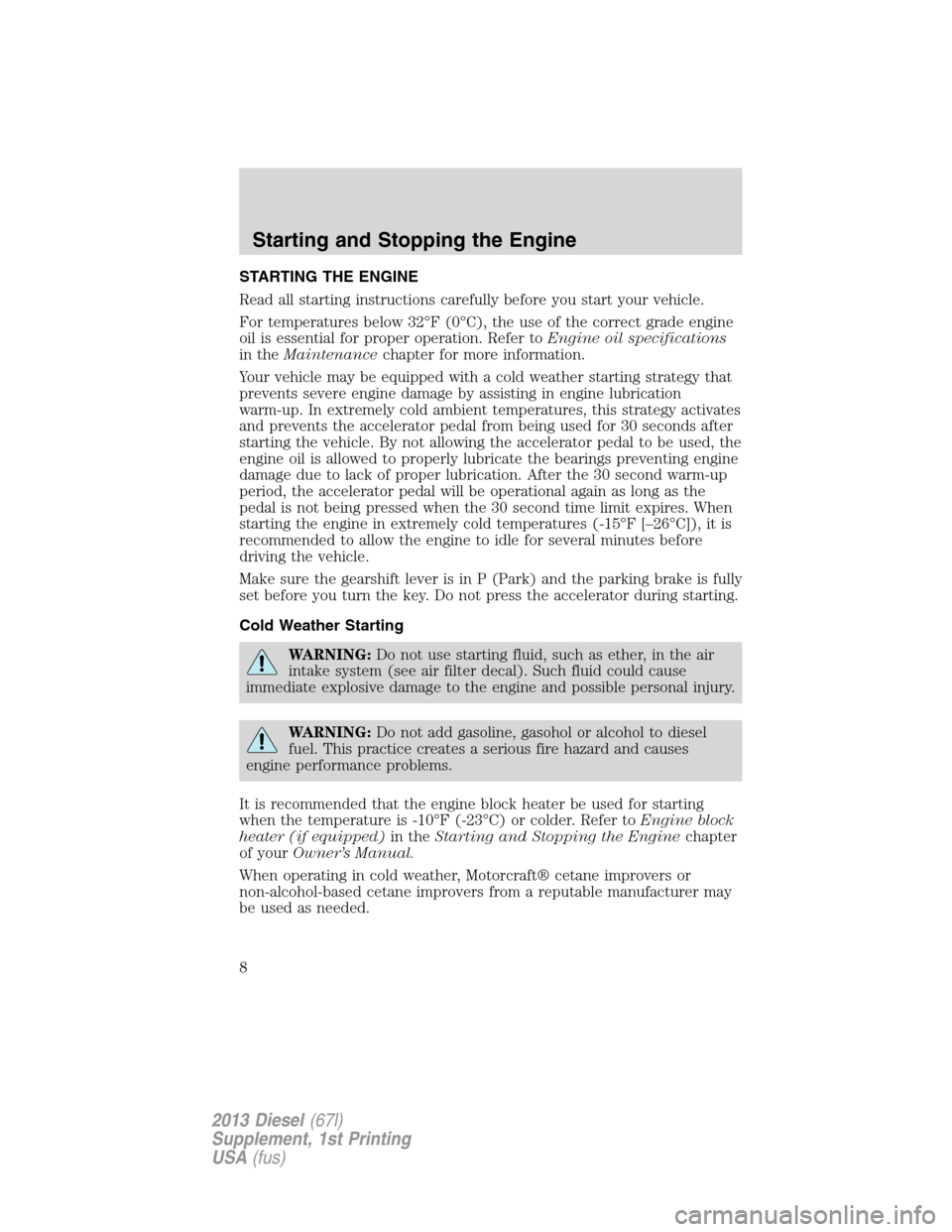
STARTING THE ENGINE
Read all starting instructions carefully before you start your vehicle.
For temperatures below 32°F (0°C), the use of the correct grade engine
oil is essential for proper operation. Refer toEngine oil specifications
in theMaintenancechapter for more information.
Your vehicle may be equipped with a cold weather starting strategy that
prevents severe engine damage by assisting in engine lubrication
warm-up. In extremely cold ambient temperatures, this strategy activates
and prevents the accelerator pedal from being used for 30 seconds after
starting the vehicle. By not allowing the accelerator pedal to be used, the
engine oil is allowed to properly lubricate the bearings preventing engine
damage due to lack of proper lubrication. After the 30 second warm-up
period, the accelerator pedal will be operational again as long as the
pedal is not being pressed when the 30 second time limit expires. When
starting the engine in extremely cold temperatures (-15°F [–26°C]), it is
recommended to allow the engine to idle for several minutes before
driving the vehicle.
Make sure the gearshift lever is in P (Park) and the parking brake is fully
set before you turn the key. Do not press the accelerator during starting.
Cold Weather Starting
WARNING:Do not use starting fluid, such as ether, in the air
intake system (see air filter decal). Such fluid could cause
immediate explosive damage to the engine and possible personal injury.
WARNING:Do not add gasoline, gasohol or alcohol to diesel
fuel. This practice creates a serious fire hazard and causes
engine performance problems.
It is recommended that the engine block heater be used for starting
when the temperature is -10°F (-23°C) or colder. Refer toEngine block
heater (if equipped)in theStarting and Stopping the Enginechapter
of yourOwner’s Manual.
When operating in cold weather, Motorcraft® cetane improvers or
non-alcohol-based cetane improvers from a reputable manufacturer may
be used as needed.
Starting and Stopping the Engine
8
2013 Diesel(67l)
Supplement, 1st Printing
USA(fus)
Page 23 of 95
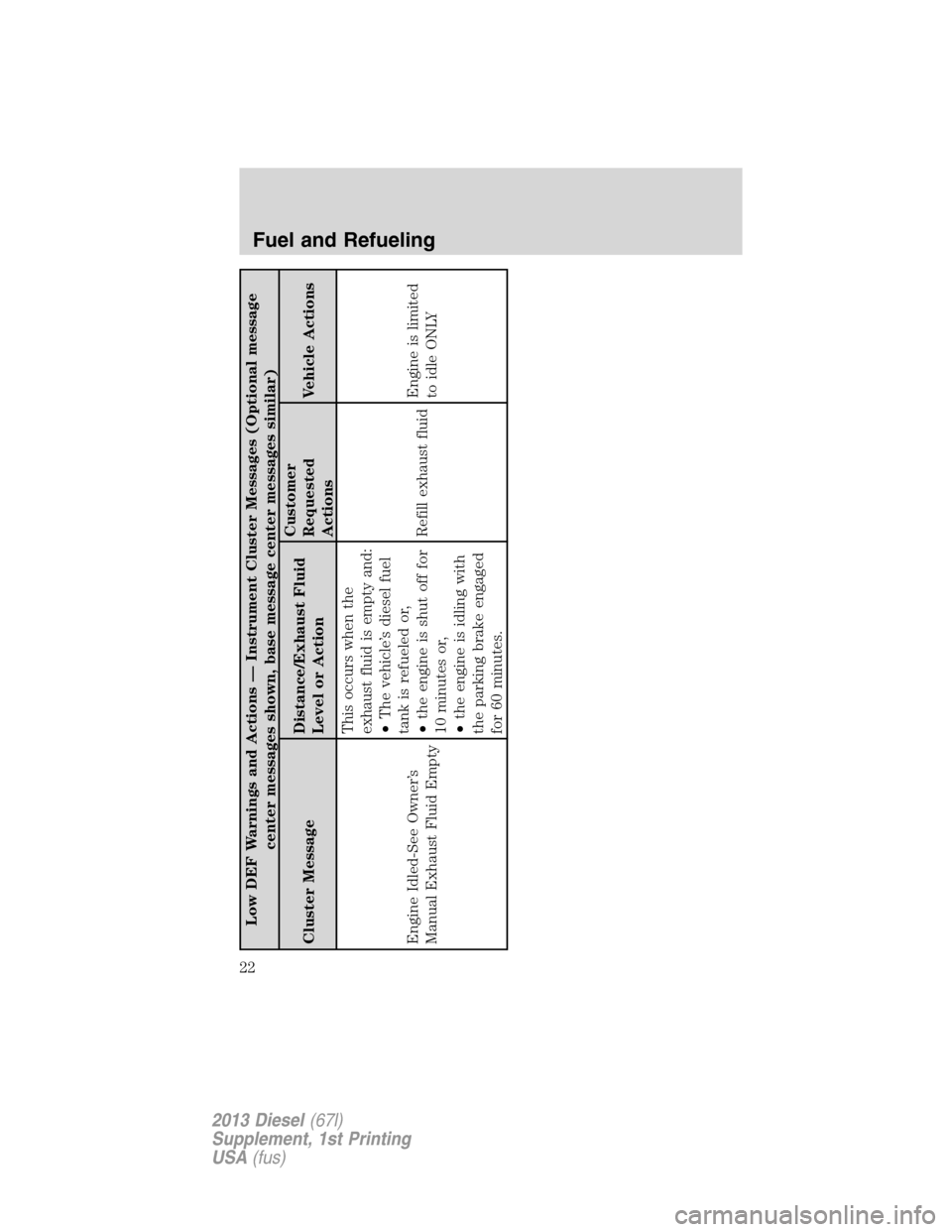
Low DEF Warnings and Actions — Instrument Cluster Messages (Optional message
center messages shown, base message center messages similar)
Cluster MessageDistance/Exhaust Fluid
Level or ActionCustomer
Requested
ActionsVehicle Actions
Engine Idled-See Owner’s
Manual Exhaust Fluid EmptyThis occurs when the
exhaust fluid is empty and:
•The vehicle’s diesel fuel
tank is refueled or,
•the engine is shut off for
10 minutes or,
•the engine is idling with
the parking brake engaged
for 60 minutes.Refill exhaust fluidEngine is limited
to idle ONLY
Fuel and Refueling
22
2013 Diesel(67l)
Supplement, 1st Printing
USA(fus)
Page 38 of 95
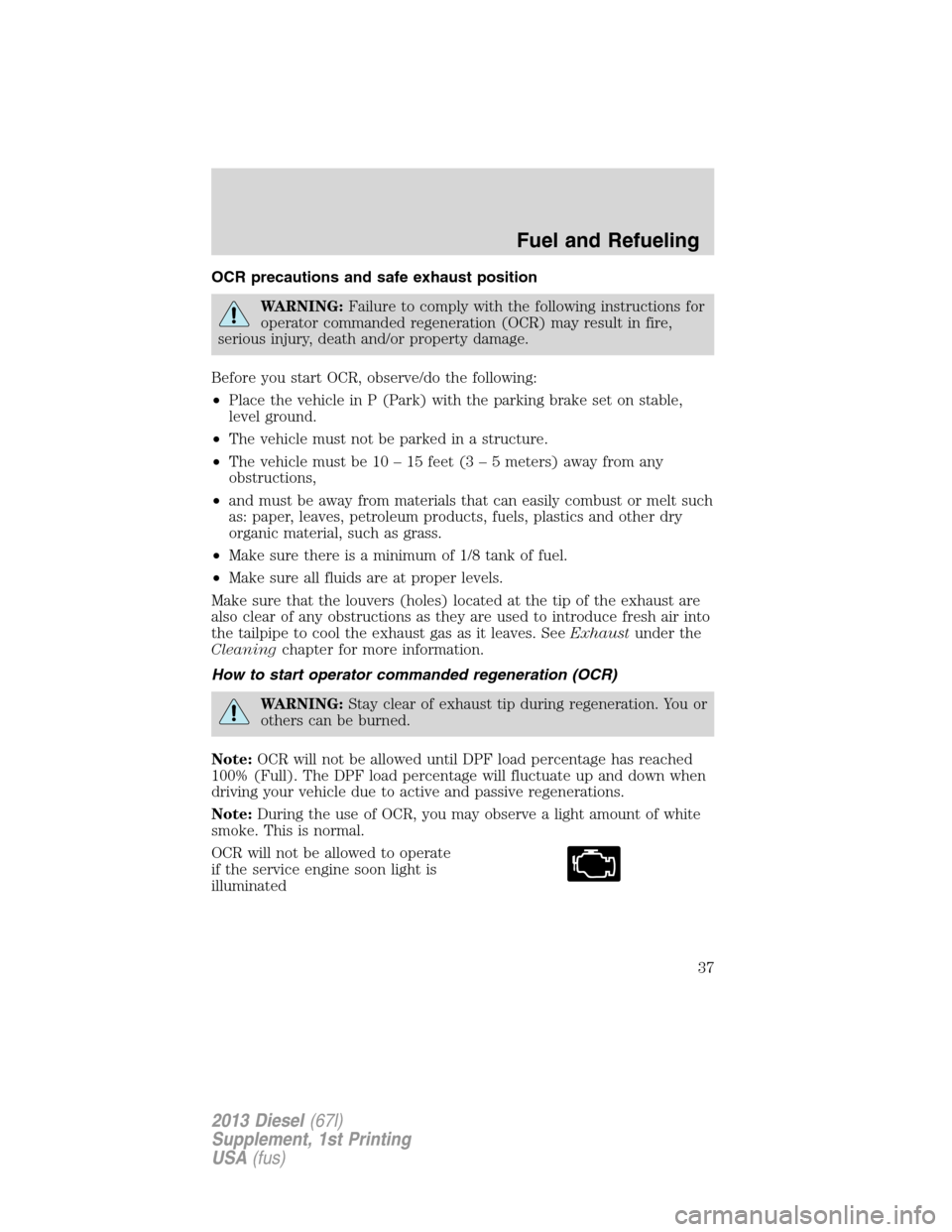
OCR precautions and safe exhaust position
WARNING:Failure to comply with the following instructions for
operator commanded regeneration (OCR) may result in fire,
serious injury, death and/or property damage.
Before you start OCR, observe/do the following:
•Place the vehicle in P (Park) with the parking brake set on stable,
level ground.
•The vehicle must not be parked in a structure.
•The vehicle must be 10 – 15 feet (3 – 5 meters) away from any
obstructions,
•and must be away from materials that can easily combust or melt such
as: paper, leaves, petroleum products, fuels, plastics and other dry
organic material, such as grass.
•Make sure there is a minimum of 1/8 tank of fuel.
•Make sure all fluids are at proper levels.
Make sure that the louvers (holes) located at the tip of the exhaust are
also clear of any obstructions as they are used to introduce fresh air into
the tailpipe to cool the exhaust gas as it leaves. SeeExhaustunder the
Cleaningchapter for more information.
How to start operator commanded regeneration (OCR)
WARNING:Stay clear of exhaust tip during regeneration. You or
others can be burned.
Note:OCR will not be allowed until DPF load percentage has reached
100% (Full). The DPF load percentage will fluctuate up and down when
driving your vehicle due to active and passive regenerations.
Note:During the use of OCR, you may observe a light amount of white
smoke. This is normal.
OCR will not be allowed to operate
if the service engine soon light is
illuminated
Fuel and Refueling
37
2013 Diesel(67l)
Supplement, 1st Printing
USA(fus)
Page 49 of 95

UNDER HOOD OVERVIEW
F-Super Duty
A. Engine oil dipstick
B. Automatic transmission dipstick
C. Brake fluid reservoir
D. Power distribution box
E. Batteries
F. Engine cooling system coolant reservoir (primary high-temperature
cooling system)
G. Power steering fluid reservoir
H. Engine oil fill
I. Engine-mounted fuel filter assembly
J. Secondary cooling system coolant reservoir
K. Air filter assembly
L. Air filter restriction gauge
M. Windshield washer fluid reservoir
MEBC
EGJKLF
DA
HI
Maintenance
48
2013 Diesel(67l)
Supplement, 1st Printing
USA(fus)
Page 74 of 95
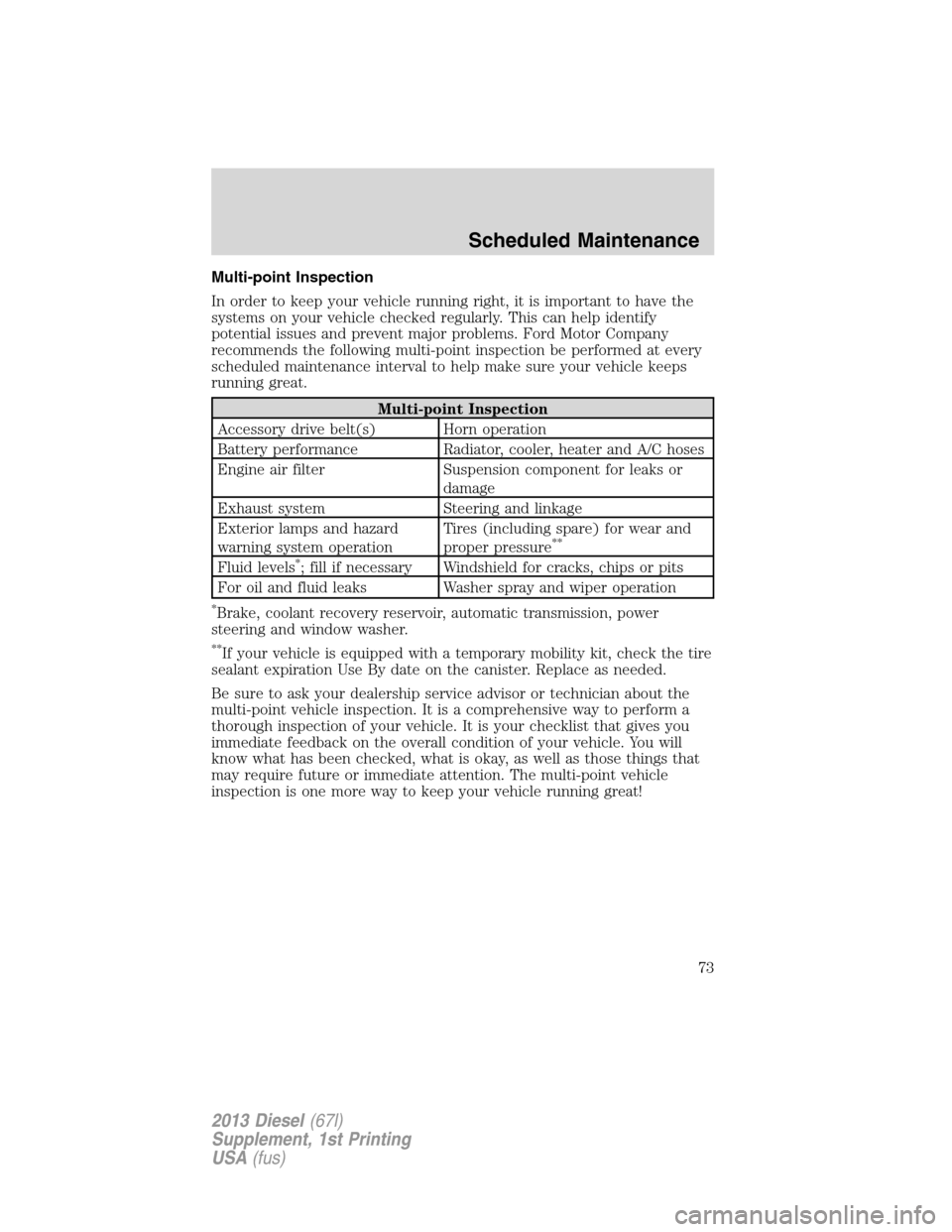
Multi-point Inspection
In order to keep your vehicle running right, it is important to have the
systems on your vehicle checked regularly. This can help identify
potential issues and prevent major problems. Ford Motor Company
recommends the following multi-point inspection be performed at every
scheduled maintenance interval to help make sure your vehicle keeps
running great.
Multi-point Inspection
Accessory drive belt(s) Horn operation
Battery performance Radiator, cooler, heater and A/C hoses
Engine air filter Suspension component for leaks or
damage
Exhaust system Steering and linkage
Exterior lamps and hazard
warning system operationTires (including spare) for wear and
proper pressure
**
Fluid levels*; fill if necessary Windshield for cracks, chips or pits
For oil and fluid leaks Washer spray and wiper operation
*Brake, coolant recovery reservoir, automatic transmission, power
steering and window washer.
**If your vehicle is equipped with a temporary mobility kit, check the tire
sealant expiration Use By date on the canister. Replace as needed.
Be sure to ask your dealership service advisor or technician about the
multi-point vehicle inspection. It is a comprehensive way to perform a
thorough inspection of your vehicle. It is your checklist that gives you
immediate feedback on the overall condition of your vehicle. You will
know what has been checked, what is okay, as well as those things that
may require future or immediate attention. The multi-point vehicle
inspection is one more way to keep your vehicle running great!
Scheduled Maintenance
73
2013 Diesel(67l)
Supplement, 1st Printing
USA(fus)
Page 77 of 95

Normal Scheduled Maintenance1
At every oil change
interval as indicated
by the information
displayChange engine oil and filter.2
Refill diesel exhaust fluid tank.
Rotate tires3, inspect tire wear and measure tread
depth.
Perform multi-point inspection (recommended).
Inspect air filter restriction gauge. Replace filter if
necessary.
Inspect automatic transmission fluid level.
Inspect brake pads, shoes, rotors, drums, brake
linings, hoses and parking brake.
Inspect engine and secondary coolant level and
hoses.
Inspect exhaust system and heat shields.
Inspect front axle and U-joints. Lubricate if equipped
with grease fittings (4WD vehicles).
Inspect steering linkage, ball joints, suspension,
tie-rod ends, driveshaft and U-joints. Lubricate if
equipped with grease fittings.
Inspect wheels and related components for abnormal
noise, wear, looseness or drag.
1Do not exceed one year or 10000 miles (16000 kilometers) between
service intervals.
2Reset your Intelligent Oil-Life Monitor® after each engine oil and filter
change. See theInformation Displaychapter of yourOwner’s Manual.
3Vehicles equipped with dual rear wheels should rotate the front wheels
when specified; rear wheels only if unusual wear is noted.
Additional Maintenance Items1
Every 15000 miles
(24000 km)Inspect engine and secondary cooling system
concentration (freeze-point protection), additive
(corrosion inhibitor) strength, coolant level and
hoses.
2
Every 22500 miles
(36000 km)Replace engine- and frame-mounted fuel filters.3
Scheduled Maintenance
76
2013 Diesel(67l)
Supplement, 1st Printing
USA(fus)
Page 87 of 95
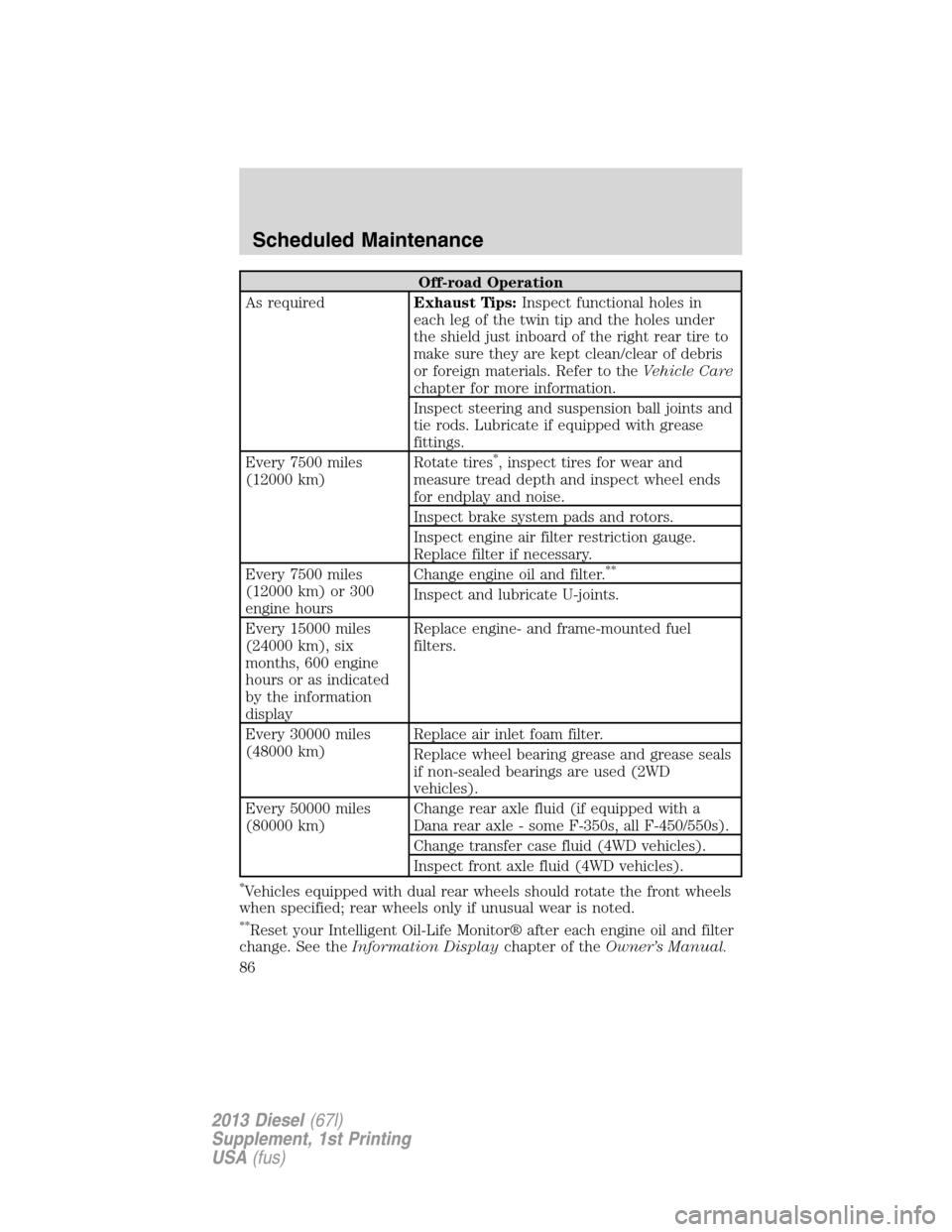
Off-road Operation
As requiredExhaust Tips:Inspect functional holes in
each leg of the twin tip and the holes under
the shield just inboard of the right rear tire to
make sure they are kept clean/clear of debris
or foreign materials. Refer to theVehicle Care
chapter for more information.
Inspect steering and suspension ball joints and
tie rods. Lubricate if equipped with grease
fittings.
Every 7500 miles
(12000 km)Rotate tires
*, inspect tires for wear and
measure tread depth and inspect wheel ends
for endplay and noise.
Inspect brake system pads and rotors.
Inspect engine air filter restriction gauge.
Replace filter if necessary.
Every 7500 miles
(12000 km) or 300
engine hoursChange engine oil and filter.
**
Inspect and lubricate U-joints.
Every 15000 miles
(24000 km), six
months, 600 engine
hours or as indicated
by the information
displayReplace engine- and frame-mounted fuel
filters.
Every 30000 miles
(48000 km)Replace air inlet foam filter.
Replace wheel bearing grease and grease seals
if non-sealed bearings are used (2WD
vehicles).
Every 50000 miles
(80000 km)Change rear axle fluid (if equipped with a
Dana rear axle - some F-350s, all F-450/550s).
Change transfer case fluid (4WD vehicles).
Inspect front axle fluid (4WD vehicles).
*Vehicles equipped with dual rear wheels should rotate the front wheels
when specified; rear wheels only if unusual wear is noted.
**Reset your Intelligent Oil-Life Monitor® after each engine oil and filter
change. See theInformation Displaychapter of theOwner’s Manual.
Scheduled Maintenance
86
2013 Diesel(67l)
Supplement, 1st Printing
USA(fus)
Page 94 of 95
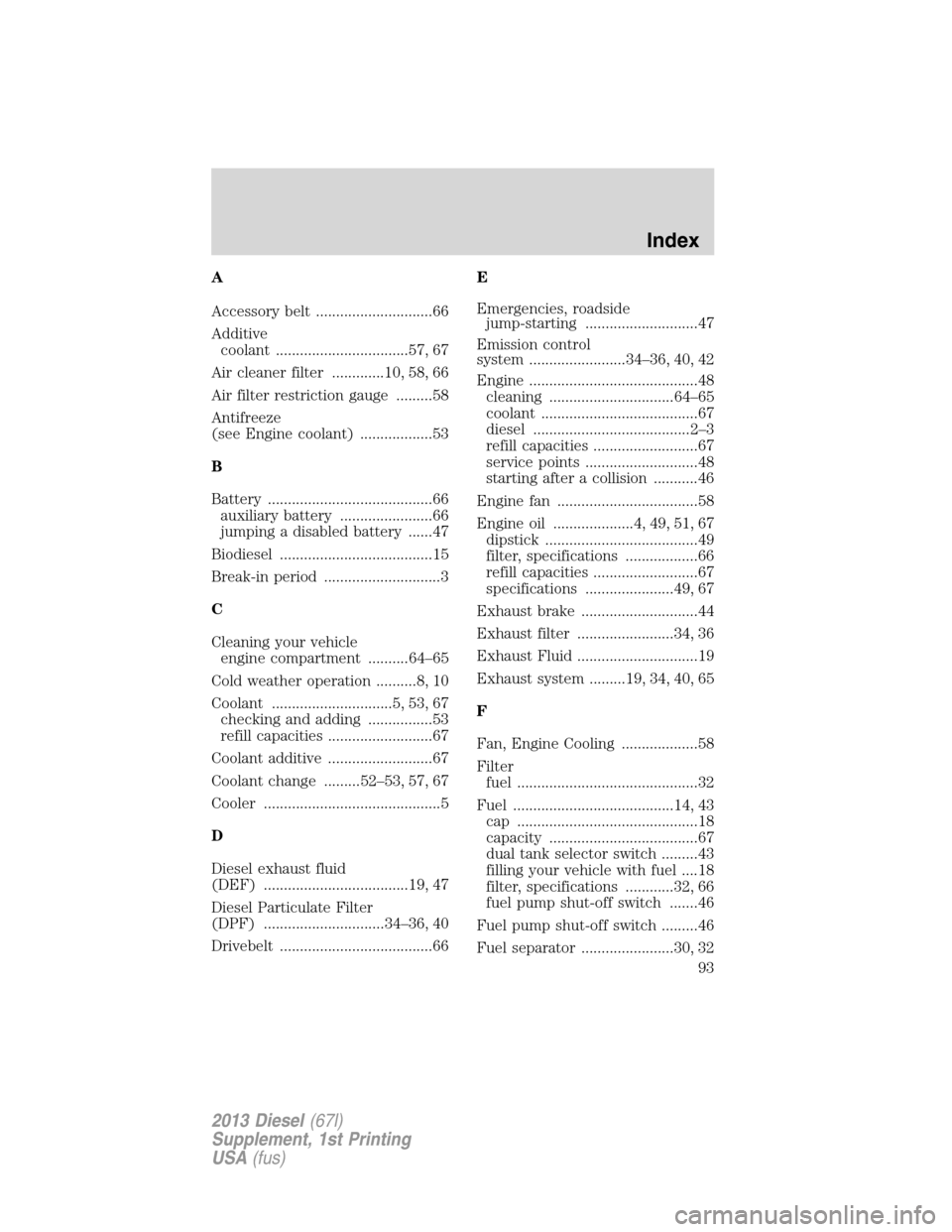
A
Accessory belt .............................66
Additive
coolant .................................57, 67
Air cleaner filter .............10, 58, 66
Air filter restriction gauge .........58
Antifreeze
(see Engine coolant) ..................53
B
Battery .........................................66
auxiliary battery .......................66
jumping a disabled battery ......47
Biodiesel ......................................15
Break-in period .............................3
C
Cleaning your vehicle
engine compartment ..........64–65
Cold weather operation ..........8, 10
Coolant ..............................5, 53, 67
checking and adding ................53
refill capacities ..........................67
Coolant additive ..........................67
Coolant change .........52–53, 57, 67
Cooler ............................................5
D
Diesel exhaust fluid
(DEF) ....................................19, 47
Diesel Particulate Filter
(DPF) ..............................34–36, 40
Drivebelt ......................................66E
Emergencies, roadside
jump-starting ............................47
Emission control
system ........................34–36, 40, 42
Engine ..........................................48
cleaning ...............................64–65
coolant .......................................67
diesel .......................................2–3
refill capacities ..........................67
service points ............................48
starting after a collision ...........46
Engine fan ...................................58
Engine oil ....................4, 49, 51, 67
dipstick ......................................49
filter, specifications ..................66
refill capacities ..........................67
specifications ......................49, 67
Exhaust brake .............................44
Exhaust filter ........................34, 36
Exhaust Fluid ..............................19
Exhaust system .........19, 34, 40, 65
F
Fan, Engine Cooling ...................58
Filter
fuel .............................................32
Fuel ........................................14, 43
cap .............................................18
capacity .....................................67
dual tank selector switch .........43
filling your vehicle with fuel ....18
filter, specifications ............32, 66
fuel pump shut-off switch .......46
Fuel pump shut-off switch .........46
Fuel separator .......................30, 32
Index
93
2013 Diesel(67l)
Supplement, 1st Printing
USA(fus)